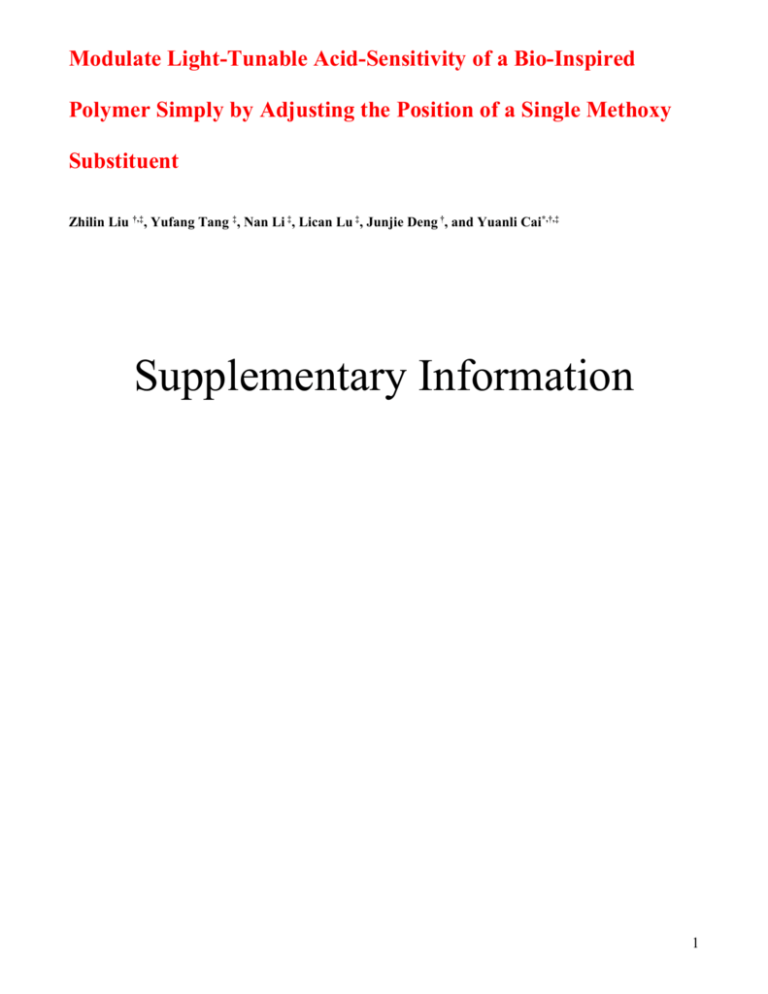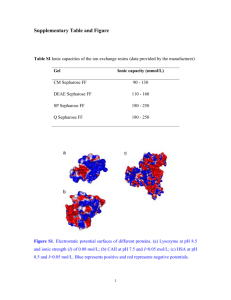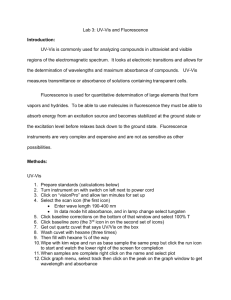Template for Electronic Submission to ACS Journals
advertisement

Modulate Light-Tunable Acid-Sensitivity of a Bio-Inspired Polymer Simply by Adjusting the Position of a Single Methoxy Substituent Zhilin Liu †,‡, Yufang Tang ‡, Nan Li ‡, Lican Lu ‡, Junjie Deng †, and Yuanli Cai*,†,‡ Supplementary Information 1 Visible light activating RAFT polymerization of EMpMSD monomer at 25 oC. The monomer conversions were assessed according to Equation S1, where I4.92–5.05 is the integral of proton signal at δ = 4.92-5.05 ppm (OCHO in cyclic acetal linkages of PEMpMSD polymer and EMpMSD monomer), I5.56 is the integral of proton signal at δ = 5.56 ppm (one proton of CH2=CCH3 of EMpMSD monomer). Conversion 1H I 4.925.05 I 5.56 I 4.925.05 (S1) NMR evidence for effect of the position of methoxy substituent on the light-triggered Z- isomerization. The degrees of Z-isomerization of PEMpMSD were assessed according to Equation S2, where I5.58 is the integral of Z-type p-CH3OC6H4CH=CH signal at δ=5.58 ppm, I6.00 is the integral of Etype p-CH3OC6H4CH=CH signal at δ=6.00 ppm. Degree of Z -isomerization = 1H I 5.58 I 5.58 I 6.00 (S2) NMR evidence for effect of the position of methoxy substituent on light-tunable acid- sensitivity. The overall degree of hydrolysis of cyclic acetal linkages in PEMpMSD was assessed according to Equation S3, where [I4.8-5.3]0 is the integral ratio of OCHO signal at δ = 4.8-5.3 ppm to the signals of protons a, g, h and i of initial PEMpMSD, and [I4.8-5.3]t is the integral ratio of OCHO signal to the total integral of proton signals of a, g, h and i of EMpMSD units without hydrolysis plus proton signals of k, j and l of hydrolyzed units (see Figure 10). Overall Degree of Hydrolysis = [ I 4.85.3 ]0 [ I 4.85.3 ]t [ I 4.85.3 ]0 (S3) Furthermore, the degree of hydrolysis of cyclic acetal linkages adjacent to either E- or Z-type chromophores was separately assessed according to Equation S4 or Equation S5, where [I6.04]0 or [I5.57]0 is the initial integral ratio of the E-type CH=CHC6H4OCH3 signal at δ=6.04 ppm or the Z-type CH=CHC6H4OCH3 signal at δ=5.57 ppm to that of signals of protons a, g, h and i at δ = 3.3-4.4 ppm; [I6.04]t or [I5.57]t is the integral ratio of the E-type CH=CHC6H4OCH3 signal to the total integral of signals of protons a, g, h and i (without hydrolysis) and k, j and l (hydrolyzed) at δ = 3.3-4.4 ppm at predetermined intervals (see Figure 10). 2 Degree of Hydrolysis (E -type) = [ I 6.04 ]0 -[ I 6.04 ]t [ I 6.04 ]0 Degrees of Hydrolysis (Z -type) = (a) a b c O b c [ I 5.57 ]0 -[ I 5.57 ]t [ I 5.57 ]0 g,h k l O OH e f (b) O g,h i c, CHCl3 d j (S4) (S5) d e c g f b O O h O i,j m a a j 8 e 7 6 Figure S1. l i,j k a CHCl3 c b d n OH f k g h i 2 h e db,f g l 5 4 3 Chemical Shift (ppm) 1H l 1 0 8 7 6 m i j 5 4 3 2 Chemical Shift (ppm) nk 1 0 NMR spectra of the CDCl3 solutions of (a) 5-ethyl-5-hydroxymethyl-2-(p- methoxystyryl)-[1,3]dioxane (EHpMSD) and (b) 5-ethyl-5-hydroxymethyl-2-(o-methoxystyryl)- [1,3]dioxane (EHoMSD). 3 15% conversion 13% conversion 31% conversion 30% conversion 47% conversion 48% conversion 61% conversion 61% conversion 69% conversion (a) 7 8 9 10 (b) 11 12 13 14 15 16 7 8 9 Elution Time (min) 10 11 12 13 14 15 16 Elution Time (min) 16% conversion 34% conversion 52% conversion 62% conversion 70% conversion (c) 7 8 9 10 11 12 13 14 15 16 Elution Time (min) Figure S2. The evolution of GPC traces of PEMpMSD synthesized via RAFT polymerization of 5ethyl-5-methacryloyloxymethyl-2-(p-methoxystyryl)-[1,3]dioxane (EMpMSD) using 2-cyanoprop-2yl(4-fluoro)dithiobenzoate (CPFDB) chain transfer agent and (2,4,6-trimethylbenzoyl)diphenylphosphine oxide (TPO) photo-initiator at the feed molar ratios of [PEMpMSD]0:[CPFDB]0: [TPO]0=50:1:0.2 (a), 150:1:0.2 (b), 200:1:0.2 (c) in 35 wt% THF upon irradiated with the mild visible light at I420 nm=150 W cm-2 at 25 °C. 4 After UV radiation For 12 h Initial PEMSD sample (a) 7 8 9 10 11 12 13 14 15 16 Elution Time (min) After UV radiation for 12 h Initial PEMpMSD sample After UV radiation for 12 h Initial PEMoMSD sample (b) 7 8 9 (c) 10 11 12 13 Elution Time (min) 14 15 16 7 8 9 10 11 12 13 14 15 16 Elution Time (min) Figure S3. The GPC trace evolution of (a) PEMSD, (b) PEMpMSD or (c) PEMoMSD after irradiated with full-wave UV light at I365 nm = 600 μW cm-2 in argon gas atmosphere at 25 °C for 12 h. 5 0.8 Hydrolysis Product: o-Methoxyphenylacrylaldehyde Absorbance 0.6 (a) 0.4 [E]:[Z]=100:0 0.2 0.0 240 270 300 330 360 Wavelength (nm) 390 420 450 0.5 Hydrolysis Product: o-Methoxyphenylacrylaldehyde Absorbance 0.4 (b) 0.3 0.2 [E]:[Z]=38:62 0.1 0.0 240 270 300 330 360 390 Wavelength (nm) 420 450 Figure S4. The evolution of UV-vis spectra of 1,4-dioxane solutions of PEMoMSD at different ratios of [E]:[Z] under the hydrolyzing conditions: added 0.25 g of 0.98 mol L-1 hydrochloric acid in 50 mL of 12.0 mg L-1 PEMoMSD solutions, and stirred at 25 °C. (a) PEMoMSD at [E]:[Z]= 100:0 (from bottom to up): 0, 10, 20, 30, 40, 50, 60, 70, 80, 90, 100, 110, 120, 150, 180, 210, 240, 270, 300 min; (b) PEMoMSD at [E]:[Z]=38:62 (from bottom to top): 0, 60, 120, 240, 360, 480, 600, 720, 900, 1080, 1260, 1440, 1620, 1800 min. 6 1.2 Hydrolysis Product: Cinnamaldehyde Absorbance 1.0 (a) 0.8 0.6 0.4 0.2 [E]:[Z]=100:0 0.0 240 270 300 330 360 390 Wavelength (nm) 420 450 0.6 Absorbance Hydrolysis Product: Cinnamaldehyde 0.4 (b) 0.2 [E]/[Z]=40:60 0.0 240 270 300 330 360 390 Wavelength (nm) 420 450 Figure S5. The evolution of UV-vis spectra of 1,4-dioxane solutions of PEMSD at different cinnamyl ratios of [E]:[Z] under the hydrolyzing conditions: added 0.25 g of 0.98 mol L-1 hydrochloric acid in 50 mL of 12.0 mg L-1 PEMSD solutions, and stirred at 25 °C. (a) PEMSD at [E]:[Z]=100:0 (from bottom to up): 0, 30, 60, 90, 120, 150, 180, 210, 240, 270, 300, 330, 360, 420, 480, 540, 600, 660, 720 min; (b) PEMSD at [E]:[Z]=40:60 (from bottom to top): 0, 60, 120, 240, 360, 480, 600, 720, 900, 1080, 1260, 1440, 1620, 1800 min. 7 1.2 (a) Absorbance 1.0 0.8 0.6 0.4 0.2 y 0.01 0.1894 x 0.0 0 1 2 3 4 -1 Concentration (mg L ) 6 0.5 1.2 (b) (c) 0.4 Absorbance 1.0 Absorbance 5 0.8 0.6 0.3 0.2 0.4 0.1 0.2 y 0.00149 0.071173 x y 0.0134 0.18061 x 0.0 0.0 0 1 2 3 4 -1 Concentration (mg L ) 5 6 0 1 2 3 4 5 6 -1 Concentration (mg L ) Figure S6. The standard curves of (a) cinnamaldehyde (λmax=284 nm), (b) p-methoxyphenylacrylaldehyde (λmax=315 nm) and (c) o-methoxyphenylacrylaldehyde (λmax=329 nm). The degrees of hydrolysis of these polymers were calculated by Equation S6, where A0 or AT is the absorbance at λmax in the initial stage or at the predetermined intervals; a or b is the intercept or slope value of the corresponding standard curve (y = a + bx); C is the concentration of theoretical completely hydrolyzed products of the aldehyde compounds. Degree of Hydrolysis = ( AT A0 ) a bC (S6) 8 p D3O+/acetone-d6 O OO O g g e,f d Od O O O (E) c' (Z) c b b + O O i h h OH OH 25 oC e,f k CHO m (E) n a a a,m,n h p [E]:[Z]=100:0 b,k f H2O e b,k p 421 min 173 min 173 min 81 min 81 min a 0 min 9 8 b c d 7 6 5 Chemical Shift (ppm) g e f 36 min 0 min 4 c 504 min 421 min 35 min 10 d f,h [E]:[Z]=40:60 i g c 504 min (b) a,m,n } } (a) 3 10 9 a b c c' d c' d 8 7 6 5 Chemical Shift (ppm) g e,i H2O g e 4 f 3 Figure S7. The evolution of 1H NMR spectrum of PEMSD at [E]:[Z]=100:0 (a) or 40:60 (b) under the hydrolyzing conditions: added 13 mg of 0.25 mol L-1 deuterated hydrochloric acid in 1.0 mL of 6.0 mg mL-1 polymer solution in acetone-d6 at 25 °C. 9



